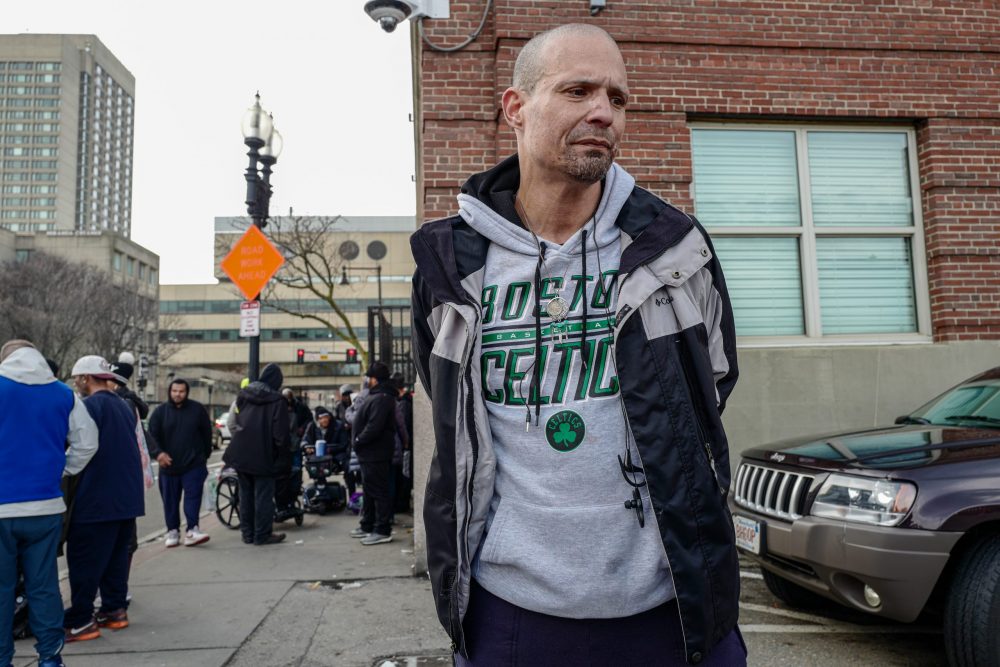Though Boston does have a visible population of people experiencing homelessness, thousands are much harder to identify | Photo by Luis Edgardo Cotto via our dispatch last week from the South End
“They’re staying at a friend’s house. They’re staying with an aunt. They’re not staying at Park Street station at one o’clock at night freezing.”
As COVID-19 strikes New England and everywhere, thousands of people are experiencing homelessness, living in shelters and on the streets. In Boston alone, more than 6,000 people were experiencing homelessness in 2019, according to the most recent Point-in-Time count.
As has been the case in prior years, though, critics worry the PIT report leaves many people experiencing homelessness uncounted.
On a cold January night, about 350 volunteers scattered across Boston. They searched in alleyways, train stations, and storefronts as part of a nationwide effort coordinated by the Department of Housing and Urban Development to measure the homeless population in the United States.
“This is who people doing the count were able to find and connect to that day,” said Kelly Turley, associate director of the Massachusetts Coalition for the Homeless. “Not a comprehensive analysis of all the people experiencing homelessness.”
While the count helps officials gauge some sense of the situation, it doesn’t yield the most accurate number, Turley said.
HUD requires the count to be conducted on a single night on one of the last 10 days of January, and it is conducted locally through continuums of care. On the night of the count, volunteers count people living in places not intended for human habitation, and homeless shelters count the people using their facilities.
There are several reasons it undercounts homelessness, according to Turley. For instance, the definition doesn’t encapsulate all types of homelessness.
HUD identifies four groups as experiencing homelessness, according to their website: people who lack a fixed, regular, and adequate residence; people who will imminently lose their nighttime residence; unaccompanied youth and families with children defined as homeless under other federal statutes; and individuals fleeing or trying to flee domestic violence.
The definition doesn’t include multiple families living in a single house unit, known as “doubling up.” This particularly excludes young people experiencing homelessness who are more likely to double up, she said.
“The way it’s conducted through HUD… Their definition of homelessness is unnecessarily narrow,” Turley said in a phone interview.
Not everyone working on homelessness takes issue with the PIT count. Joe Finn, president and executive director of the Massachusetts Housing and Shelter Alliance, said the count provides valuable insights into homelessness.
While Finn agreed it’s unrealistic to gauge the entirety of homelessness on one night, he said the PIT count helps officials understand homelessness and locate people who aren’t on the chronic homeless list.
“Measurement is imperfect,” he said. “It doesn’t mean we use it as an excuse not to do anything.”
Local groups and governmental organizations have pushed attempts to improve upon the PIT by conducting a separate count of youth homelessness and conducting the count statewide.
Bridge Over Troubled Waters, a Boston-based nonprofit that works on youth homelessness, joined a nationally-coordinated youth count to more accurately count youth homelessness. Elisabeth Jackson, the group’s executive director, said youth homelessness appears different from other types of homelessness, so counting them separately provides more accurate measurements. Young people experiencing homelessness are often more transitory than older populations, so they’re harder to count.
“[Young people] move around,” she said. “They don’t stay in one place.”
They also more easily blend into the general population.
“They assimilate,” Jackson said. “You would not be able to pick out a homeless youth if you looked outside.”
It can be more difficult for them to deal with homelessness because their brains are still developing, according to Jackson. They are often less trusting and more embarrassed than older people to willingly identify themselves as homeless.
“It’s harder for somebody whose brain is developmentally building to really figure out, ‘Okay, I have to pay $3,000 for an apartment. I don’t have the credit to do so. I don’t have a job that makes that much. I’m still in high school. I need to graduate school,’” Jackson said. “There’s a lot of other things involved for a young person.”
Young people experiencing homelessness are also more likely to couch-surf.
“They’re staying at a friend’s house. They’re staying with an aunt,” Jackson noted. “They’re not staying at Park Street station at one o’clock at night freezing.”
After youth providers raised concerns that young people weren’t being counted in the PIT count, Chapin Hall, a research center at the University of Chicago, began the Voices of Youth count in 2015 with HUD funding. Massachusetts was one of 10 states initially selected for the count.
The youth count is conducted entirely by other young people. Counters take to the streets with backpacks that read “youth count” and clipboards to count young people experiencing homelessness. They also hold meetings.
“[Young people] know where [their] friends are more than me,” Jackson said.
According to Jackson, the ideal way to conduct the count would be for all Massachusetts schools to require every student to take a survey about youth homelessness on the same day.
“It doesn’t stigmatize,” she said. “When you’re talking about homeless youth, you can’t separate them.”
The count lasts for two weeks, opposed to the one night allocated for the PIT, because young people move around more often. Still, Jackson said the Voices of Youth count effort lacks adequate funding in Boston. Bridge Over Troubled Waters, the group that oversees the effort, receives $6,000 from the state, $5,000 from Boston, and outside financial support from Liberty Mutual, but there is no additional federal funding. To effectively conduct the count in this region, the organization would need anywhere from $50,000 to $100,000 to pay counters and to have a presence in all Boston schools, Jackson estimated.
“It’s mostly done to show this is why we need financial support for runaway homeless youth,” she said. “The only way that we can get government money is by saying, These are the numbers, here we are.”
Efforts have been underway since 2018 to establish a clearinghouse in Massachusetts that would allow data from each Massachusetts continuum of care to be shared among the state and other continuums, Linn Torto said. The executive director of the Interagency Council on Homelessness, Torto also lamented that PIT data is not released to the state until nearly a year after the count occurs, making it difficult to identify trends. Date from the 2019 survey was not released until two weeks before the 2020 count.
“It doesn’t do us any good if there’s a Point-in-Time in 2019 and we find out there’s been an increase or decrease in homeless veterans,” Torto said.
With the sharing model, people at each point in the continuum of care will be able to upload their data on a regular basis, while people experiencing homelessness would have the option of signing a release form. If they decline, their information will be shared only on a de-identified basis. Only discrete, select people will have access to identifying information, Torto said.
The data warehouse will also provide insights into people experiencing homelessness who move from community to community, she noted.
“If someone becomes homeless in Haverhill but decides to go to Leominster … right now, we can’t track that person,” she said.
Torto hoped the data warehouse would be up and running by July, with data coming online after. With the coronavirus crisis afoot, it will seemingly be a hard target to hit. People experiencing homelessness, as well as the individuals who work with that population, are among the busiest, hardest pressed, and most vulnerable groups. Of course, when facing a threat like COVID-19, information is especially valuable.
“The more we know about them,” Torto said, “the more we can help them.”









